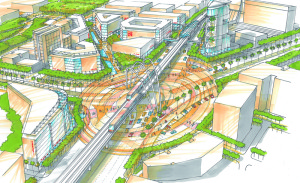By Matthew Varcak
A public transit system does more than just get people from point A to point B.
“Cities can be defined by transit systems,” said Jeff Doble, director of transportation design for the Vancouver office of Perkins+Will. “A station’s design affects the whole community. It affects future development.”
Doble is playing a key role in the future of one of the world’s most dynamic cities, Riyadh, Saudi Arabia. He and his team recently completed the preliminary design of the new Riyadh Metro System and Bus Rapid Transit System — the largest transit system in the world to be designed and built at one time.
“The goal is to get an oil rich population out of cars and into public transit,” Doble said. In order to convince them to do this, mass transit must be more comfortable, convenient, and a high quality experience for passengers.
But designing such systems is an everyday event for his company. A global architecture and design firm for everything from the aviation to the transit industry, Perkins+Will currently has projects under way all over the world.
Among other projects, Doble’s work has him developing stations for the Evergreen Line in Vancouver, British Columbia, and for the elevated rail line on Oahu, Hawaii, which we spotlighted in an earlier article. The city of Riyadh is partly defined by a lack of public transportation and the presence of congested streets. The city’s population is projected to increase by 2.5 million by 2030.
The Metro and BRT systems are expected to be built within the next four years, according to Perkins+Will’s website. Once complete, the Metro will consist of roughly 110 miles of rail along six different lines and include 80 stations which will be above-grade, at-grade and below-grade. The BRT will consist of more than 50 stations and include hundreds of community bus stops.
Consistency will be established throughout the Metro and BRT stations a coordinated family, repeating design forms such as the shading canopy. Large translucent glass panels will be used to allow daylight to penetrate, especially important for the below-grade stations. The stations will also employ photovoltaic panels to shield them from direct sunlight.
Doble says all clients, regardless of locale, look to accomplish several goals when developing a transit system. We’ll explore those goals in our next story.

